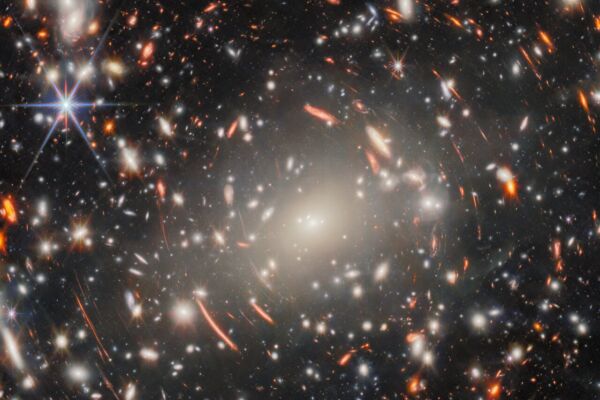In a groundbreaking discovery, the James Webb Space Telescope managed jointly by NASA and the European Space Agency (ESA) has captured a distant massive galaxy cluster. This marks the most in-depth observation conducted by the telescope on a single target, spanning approximately 120 hours.
ESA announced on May 27th the “Picture of the Month” captured by the James Webb Space Telescope. In this image, the galaxy cluster Abell S1063, located in the Grus constellation and situated 4.5 billion light-years away from Earth, dominates the entire field of view.
Upon closer inspection, the image reveals glowing arcs surrounding these galaxies, with these twisted curves being the true object of fascination for scientists as they represent faint galaxies from the distant past of the universe.
Another space telescope managed by NASA and ESA, the Hubble Space Telescope, had previously observed Abell S1063. This cluster acts as a powerful gravitational lens, bending the light from far-off galaxies behind it, creating the distorted arcs we see today.
Similar to a glass lens, this cluster focuses the light from these distant galaxies. Though the images captured by the Hubble Space Telescope may be somewhat distorted, they are still bright and magnified, providing ample material for observation and study. The purpose of utilizing the Hubble Space Telescope for observations is to use galaxy clusters as magnifying glasses to study the early universe.
The new image captured by the James Webb Space Telescope allows for an even deeper exploration into the past. Displaying numerous incredible lensing arcs around Abell S1063, it reveals distorted galaxies at different distances in the background, along with a plethora of faint galaxies and previously unseen features.
This is a deep field image, a long-exposure capture of a single area in space to gather as much light as possible, depicting the faintest and most distant galaxies that wouldn’t be visible in ordinary images.
This marks the most in-depth observation conducted by the James Webb Space Telescope on a single target to date, requiring approximately 120 hours in total. Through the gravitational lensing effect of Abell S1063, the telescope captured nine individual snapshots in different near-infrared wavelengths.
Therefore, focusing this observational capability on massive gravitational lenses like Abell S1063 holds the potential to unveil the first batch of galaxies formed in the early universe.
The James Webb Space Telescope is currently the most powerful space telescope in terms of observational capability. Since its launch in 2022, the telescope has ushered in a new era of scientific breakthroughs. The galaxies revealed in the early universe by the telescope are much larger than what scientists had anticipated.
NASA states that the James Webb Space Telescope can be used to study every stage of cosmic history, including the first light after the Big Bang, the formation of various galaxies, and the evolution of solar systems.
The James Webb Space Telescope was launched into space on December 25, 2021. Unlike the Hubble Space Telescope, it does not orbit Earth but rather orbits around the sun at the second Lagrange point(L2), approximately 1.5 million kilometers away from Earth.

